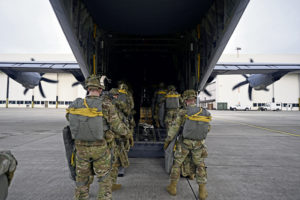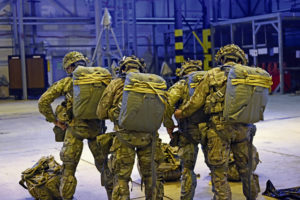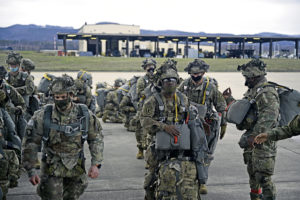
The U.S. Army’s 173rd Airborne Brigade joined forces with the 37th Airlift Squadron to conduct a rapid deployment exercise of personnel and equipment on Jan. 20.
“This joint exercise by the 1st Squadron, 91st Cavalry Regiment, 173rd Airborne Brigade and the 86th Airlift Wing demonstrates that the 173rd Air Brigade can rapidly deploy from anywhere to meet our Army Contingency Response Force mission in support of U.S. Army Europe and Africa,” said U.S. Army Lt. Col. Josh Brown 1-91 CAV commander.
As part of the Army Contingency Response Force in Europe, elements of the 173rd Air Brigade can rapidly deploy to conduct contingency operations in Europe, Africa and Asia. To do this well, both organizations coordinate regularly to conduct these deployment readiness exercises.
Since Aug. 2020, the 173rd Air Brigade has expanded its responsibilities, aligning with the U.S Army’s Southern European Task Force – Africa, and gaining expanded alert requirements supporting U.S. Africa Command in addition to U.S. European Command.
“The Air Brigade is a rapidly deployable, Airborne Cavalry Squadron responsible for maintaining a cohesive, combat ready, army contingency response force,” Brown said.

Strengthening interoperability, the 173rd AB worked seamlessly with the 37th AS and 86th AW air and ground assets to further enhance their training and mission capabilities.
“As the primary C-130J Super Hercules aircraft lift asset in Germany and Italy, the 37th AS and the 173rd Airborne maintain a strong working relationship in support of fixed wing air support,” Brown said. “Our professional and personal relationships bolster the combat readiness of the 173rd allowing us to provide a critical capability as Europe and Africa’s emergency responders.”
The 173rd Airborne Brigade and their joint partners in the 37th AS routinely conduct deployment readiness exercises from both Germany and Italy into numerous drop zones in Europe. Exercises like this set the foundation for expanding the joint capability to deploy both Airborne and Stryker capabilities anywhere in support of EUCOM, AFRICOM and U.S. Central Command priorities.
“We provide a ready-now option that is tailorable and scalable to commanders at echelon in the EUCOM, CENTCOM and AFRICOM through execution of rapid, no-notice deployment in support of non-standard mission sets,” Brown said.
During the training exercise, approximately 130 paratroopers, additional personnel, numerous vehicles, containers and supply pallets deployed from Grafenwoehr to Ramstein Air Base within hours of notification.

“During Airborne operations, we hone our paratroopers’ proficiencies and competencies to ensure our paratroopers can conduct their jobs and meet the commander’s intent,” said U.S Army Capt. Dean Purpura, 1-91 Cavalry air operations and training officer.
Once the paratroopers arrived at Ramstein they immediately initiated mission planning, joint rehearsals and the air-load process with 37th AS loadmasters to prepare for their follow-on mission.
Capping off the exercise, 1-91 Cavalry conducted static-line jumps back into Grafenwoehr Training Area from a C-130J Super Hercules aircraft while being supported by 37th AS pilots and loadmasters.
“This mission is more than just an Airborne operation,” Brown said. “It is a truly joint and multifunction endeavor, and relies on a great number of organizations all seamlessly working together. This is why we must practice these missions under multiple conditions, and often.”







